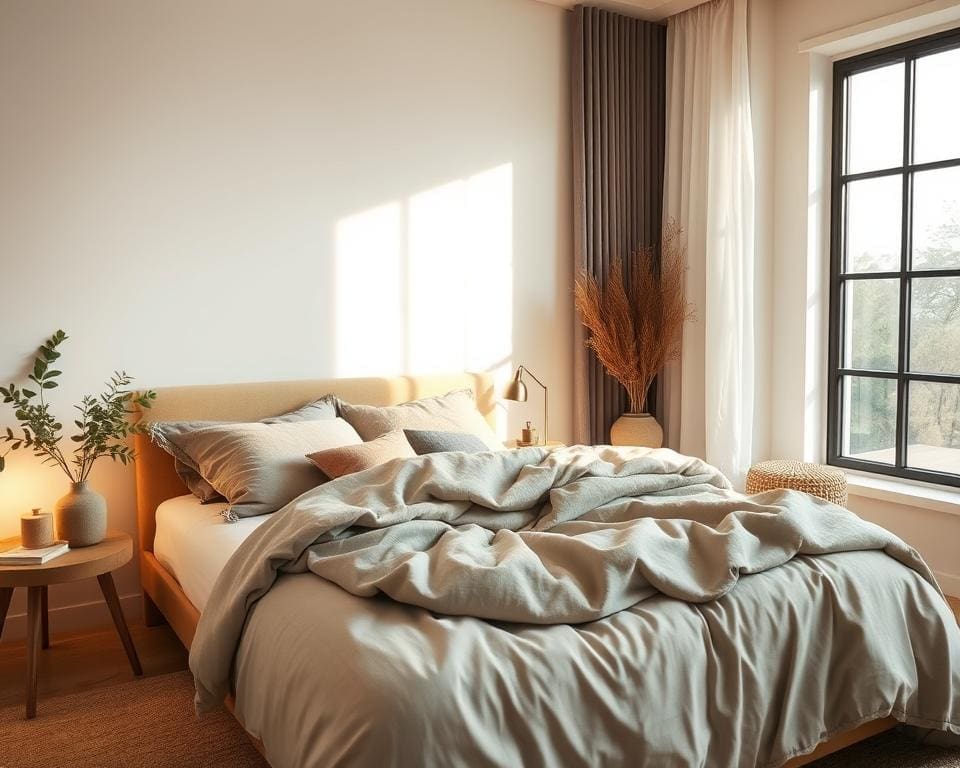Creating a calm bedroom is essential for cultivating a serene sanctuary that encourages relaxation and restful sleep. As you embark on the journey of selecting serene bedroom hues, understanding how colour influences mood is crucial. But how do you choose colours for a calm bedroom? By delving into the principles of bedroom colour psychology, you can identify a calming bedroom colour scheme that reflects personal tastes while fostering tranquillity. This section will guide you through the significance of colour in transforming your bedroom into a peaceful retreat.
Understanding the Importance of Colour in Your Bedroom
Colour plays a vital role in the atmosphere of your bedroom, significantly impacting emotions and overall mood. Understanding bedroom colour psychology can help individuals make informed decisions, shaping a calming bedroom colour scheme tailored to promote relaxation. Soft hues such as pastels often foster feelings of peace, while bolder shades can energise or even overwhelm the senses.
Research has consistently indicated that specific colours, particularly blues and greens, are inherently calming, making them excellent choices for creating a calming bedroom atmosphere. These shades not only contribute to relaxation but can also improve sleep quality by inducing a sense of tranquillity.
Natural light plays an essential role in how colours are perceived, showcasing how a calming bedroom colour scheme can change its feel throughout the day. The interplay between light and colour significantly alters the mood and energy within the space, making it crucial to consider the influence of daylight when selecting colours for a serene bedroom environment.

How do you choose colours for a calm bedroom?
Choosing the right colours for a calm bedroom involves understanding their psychological effects on mood and well-being. The principles of bedroom colour psychology guide you in selecting hues that not only enhance aesthetics but also promote mental tranquillity and comfort. A thoughtfully curated peaceful bedroom colour palette can transform your space into a serene sanctuary.
Exploring Colour Psychology for Bedrooms
Familiar colours can have a profound impact on mental health. Soft blues and greens are renowned for creating a calming environment, as they evoke feelings of nature and openness. Incorporating these shades allows for a soothing atmosphere that fosters relaxation and peace.
Neutral tones serve as an excellent foundation, allowing for versatility in decor. They can be paired with vibrant accents to create a balanced approach that avoids overstimulation. For instance, introducing pastel accents against a soft grey can enhance the peaceful ambiance without overwhelming the senses.
Real-life case studies demonstrate the effectiveness of selecting serene bedroom hues. Many homeowners have successfully transformed their spaces with muted earthy tones, promoting a sense of grounding and serenity. Such colour choices can elevate the emotional well-being of the inhabitants, making it vital to consider personal responses to various shades.
Creating a Calming Bedroom Atmosphere
Creating a calming bedroom atmosphere involves a multifaceted approach that marries colour choices with natural elements. The use of calming bedroom colour schemes together with organic materials fosters a soothing environment where relaxation can flourish.
Incorporating Natural Elements
To enhance the tranquillity of your space, consider incorporating natural materials such as wood and organic fabrics. These textures not only complement your colour choices but also evoke feelings of warmth and comfort. To further enrich the ambience, introduce indoor plants and nature-inspired artwork, which breathe life into the room and elevate the overall atmosphere.
Using Light and Dark Shades Effectively
The interplay of light and dark shades in your calming bedroom colour scheme can drastically influence the perception of space. Light shades tend to open up a room, creating an airy feel, while darker shades can provide an intimate, cocoon-like atmosphere. To perfectly balance these effects, use light shades on larger surfaces and incorporate darker tones in accessories or smaller areas. This thoughtful approach ensures that you maintain a serene feel without overwhelming the senses.
Best Colours for a Peaceful Bedroom
Choosing the right colours for a bedroom plays a crucial role in creating a tranquil space that promotes relaxation and serenity. The best colours for a peaceful bedroom often include soft neutrals and cool tones that provide a soothing backdrop for your sanctuary. In this section, we will explore these options in detail, helping you to select a calming bedroom colour scheme that aligns with your personal style.
Soft Neutrals for Serenity
Soft neutrals, such as beiges, creams, and light greys, serve as perfect foundations for a calming atmosphere. These shades create a sense of warmth and comfort, allowing you to easily incorporate various accessories and textures. Soft neutrals offer the flexibility to choose accent pieces that add personality without overwhelming the space. Incorporating furniture and decor in natural materials can further enhance this serene vibe.
Cool Tones to Promote Relaxation
Cool tones like ocean blues, mint greens, and gentle lavenders are known to instil a sense of calm and peace. These colours evoke feelings of tranquillity, reminiscent of nature and open skies. By employing a tranquil bedroom colour selection that focuses on these hues, you set the stage for restful nights and rejuvenating mornings. Experimenting with soft bedding and delicate curtains in these shades helps to maintain a cohesive and soothing ambience.
A key aspect of creating a calming bedroom colour scheme lies in achieving balance. Ensure that your selected hues work harmoniously together, avoiding any harsh contrasts that may disrupt the peaceful atmosphere. A well-thought-out palette not only enhances the aesthetic but also promotes a deeper sense of tranquillity and relaxation.
Calming Bedroom Colour Tips
Creating a peaceful sanctuary within your bedroom involves thoughtful choices regarding colour. Implementing calming bedroom colour tips can transform a chaotic environment into a tranquil retreat. Consider layering hues and understanding the impacts of accent walls in contrast to full room colour to enhance visual appeal while promoting relaxation.
Layering and Mixing Hues
Layering colours through various materials and textiles adds depth to the space without creating a cluttered look. For instance, combining soft linens in pastel shades with textured throws can enhance the overall tranquillity. A carefully considered tranquil bedroom colour selection encourages the use of different shades in a harmonious way, working together to create a serene atmosphere. Aim for a balance between contrasting textures while maintaining a cohesive colour palette that doesn’t overwhelm the senses.
Accent Walls vs. Full Room Colour
The debate between accent walls vs. full room colour is an essential consideration when designing a calming bedroom. An accent wall can draw attention to a particular area, serving as a focal point without sacrificing overall tranquillity. On the other hand, a unified full room colour creates a seamless and expansive feel, which may be more conducive to relaxation. Weigh the benefits of visual interest against a soothing backdrop, and choose what resonates best with your sense of calm.
Serene Bedroom Colour Inspiration
Finding the perfect palette to cultivate a tranquil environment is an exciting journey. Real-life examples can offer invaluable insights, highlighting how certain colour schemes can effectively create a calming atmosphere. Leading interior designers such as Joanna Gaines and Kelly Hoppen showcase the beauty of understated elegance through their serene bedroom colour inspiration. By examining their work, individuals can visualize how to master a calming bedroom colour scheme for their spaces.
Real-Life Examples and Case Studies
When seeking inspiration, it makes sense to observe spaces transformed using soft hues and minimalist approaches. Many designers focus on using colours like gentle blues, soft greens, and neutral shades to evoke a sense of peace. Notable projects include:
- The White Room by Kelly Hoppen, featuring a blend of subtle pastels that complement natural light.
- Scandinavian Bedroom Retreat designed by Studio McGee, showcasing a calming palette of muted greys and whites to promote relaxation.
- The Urban Oasis by Sarah Richardson, implementing earth tones through textiles and accents that create an inviting atmosphere.
Interior Design Trends for Calming Spaces
Current interior design trends emphasise the importance of colour in crafting calming environments. Key trends include:
- Minimalism: Clean lines and unadorned spaces allow colour to breathe, focusing on a select few hues.
- Biophilic Design: Integrating nature-inspired colours that reflect outdoor scenery engages the senses while promoting serenity.
- Scandinavian Influence: This style utilises muted colours paired with warm accents, creating a comforting and cohesive look.
Drawing inspiration from these trends encourages individuals to reflect on their tastes. Creating a calming environment becomes a personal journey, allowing one to blend tranquillity with individuality. Embracing this process can lead to spaces that truly reflect style and serenity.
Selecting Serene Bedroom Hues
Choosing the right colours for a calming bedroom is essential for crafting a sanctuary that promotes relaxation. As we have explored, soft neutrals and cool tones are among the best colours for a peaceful bedroom. Whether you opt for gentle greys, tranquil blues, or muted greens, these shades can create an atmosphere that encourages serenity and restfulness. Understanding the fundamentals of selecting serene bedroom hues will help you make informed decisions that resonate with your personal style.
When selecting serene bedroom hues, it’s vital to experiment with different combinations and shades to find what truly speaks to you. Incorporating tips on layering hues can add depth and character to your space while maintaining the calming essence you desire. Remember, your bedroom is a personal retreat, and employing calming bedroom colour tips will empower you to create an environment that reflects your unique preferences and fosters tranquillity.
In conclusion, your bedroom should be a reflection of who you are, harmoniously aligned with the principles of colour theory that enhance peace and relaxation. By harnessing the insights shared about selecting serene bedroom hues, you’ll be well on your way to transforming your bedroom into a calming oasis tailored just for you. Embrace the journey of rediscovery and watch as your space evolves into a haven of serenity.









